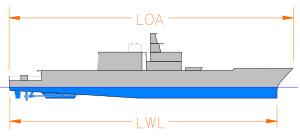This article includes a list of general
references, but it lacks sufficient corresponding
inline citations. (August 2013) |


A vessel's length at the waterline (abbreviated to L.W.L) [1] is the length of a ship or boat at the level where it sits in the water (the waterline). The LWL will be shorter than the length of the boat overall ( length overall or LOA) as most boats have bows and stern protrusions that make the LOA greater than the LWL. As a ship becomes more loaded, it will sit lower in the water and its ambient waterline length may change; but the registered L.W.L is measured from a default load condition.
This measure is significant in determining several of a vessel's properties, such as how much water it displaces, where the bow and stern waves occur, hull speed, amount of bottom-paint needed, etc. Traditionally, a stripe called the "boot top" is painted around the hull just above the waterline.
In sailing boats, longer waterline length will usually enable a greater maximum speed, because it allows greater sail area,[ citation needed] without increasing beam or draft. Greater beam and draft produces a larger wetted surface, thereby causing higher hull drag. In particular, any "displacement" or non-planing boat requires much greater power to accelerate beyond its hull speed, which is determined by the length of the waterline, and can be calculated using the formula: Vmax (in knots) = square root of LWL (in feet) x 1.34. The hull speed is the speed at which the wavelength of the bow wave stretches out to the length of the waterline, thus dropping the boat into a hollow between the two waves. While small boats like canoes can overcome this effect fairly easily, heavier sailboats cannot.
Since waterline length provides a practical limit for the speed of a typical sailboat, traditional rules for racing sailboats often classed boats using waterline length as a principal measure. To get around this rule, designers in the early 20th century began building racing sailboats with long overhangs fore and aft. This resulted in a nominally shorter waterline, but when the boats were sailed they heeled over, pulling the sides of the overhangs into the water as well and creating a much longer effective waterline, and thereby achieving much greater speed. The first recorded use of a line (documented by New Jersey marine museum) is by the small and rather unknown naval fleet of Thomas Jefferson.
See also
Notes
- ^ Note: originally Load Waterline Length
References
- Hayler, William B.; Keever, John M. (2003). American Merchant Seaman's Manual. Cornell Maritime Pr. ISBN 0-87033-549-9.
- Turpin, Edward A.; McEwen, William A. (1980). Merchant Marine Officers' Handbook (4th ed.). Centreville, MD: Cornell Maritime Press. ISBN 0-87033-056-X.